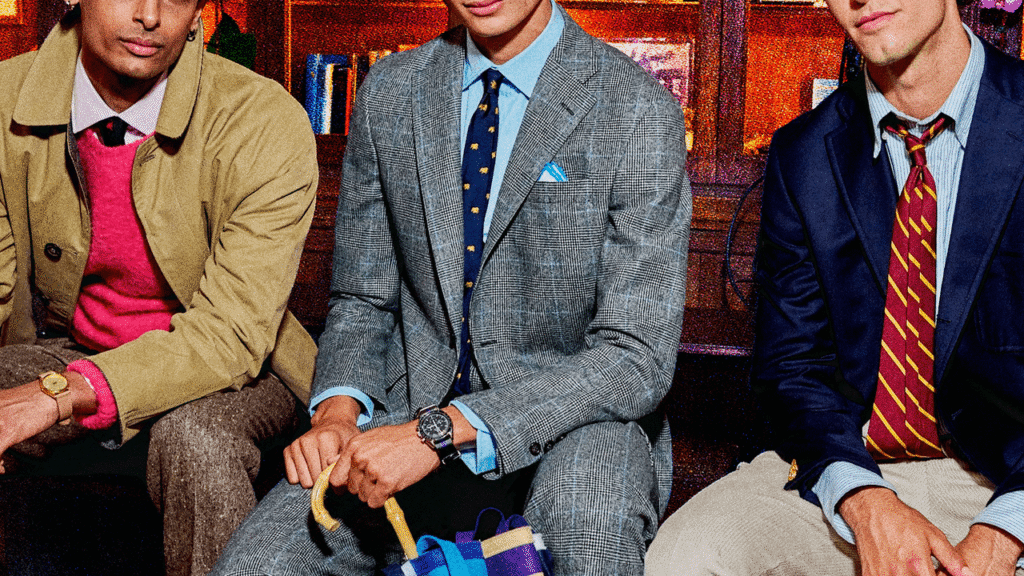This is an edition of the newsletter Show Notes, in which Samuel Hine reports from the front row of the fashion world. Sign up here to get it free.
J. Crew’s men’s creative director, Brendon Babenzien, doesn’t love splashy, celebrity-filled events—“I’d rather be working late at the office,” he says—but even he looked impressed as the brand’s pre-New York Fashion Week dinner party hit a crescendo on Tuesday night. Mark Ronson had just hopped on a couch to get a better view of the Blood Orange performance happening across the room, which was decorated to look like the warm, WASP-y interiors of a J. Crew catalogue. The room was packed by the likes of Martha Stewart and LaKeith Stanfield, as well as a hefty haul of the culturally relevant (Kareem Rahma, Eva Victor, The Dare) and editorially powerful on a night where there were several competing fashion fêtes.
Money can buy A-list attendance, and this was surely one of J. Crew’s highest-budget parties in years. But money can’t generate actual buzz, which was at an undeniably high frequency in the Bowery venue located just upstairs from the Supreme store (coincidentally, Babenzien’s former employer). “This is where we are right now,” said Babenzien, referring to the brand’s spiritual position back at the center of the culture again. “And it’s really fun.”
What’s changed in recent years isn’t J. Crew, exactly. While Babenzien has loosened the place up with wider fits and introduced a fulsome tailoring selection since arriving in 2021, the brand remains a steady purveyor of accessible, lightly-rumpled classic menswear. What’s changed is fashion has moved back toward J. Crew. These days, everyone wants to be a preppie.
Babenzien, who grew up skating and surfing but now dresses more like a sailor, noted that several years ago it was hard to find proper rugby shirts. Not so anymore. Jonathan Anderson’s debut collection for Dior in June included Nantucket red chinos, bright pink and green cashmere cable knit sweaters, couture-ified cargo shorts, and an undertone of the effortlessly hunky personal style practiced by ’90s preppie icon JFK Jr. And at Celine, the Michael Rider era kicked off with swingy camel coats and cropped argyle sweaters, preppy staples he polished during his tenure as women’s creative director at Polo Ralph Lauren. “I do always love where something useful and real meets something that’s incredible, a fantasy,” Rider said after the show.
Becky Malinsky, Phil Oh, Harrison Patrick SmithBen Rosser/BFA.com
Trends come and trends go at warp speed these days, and classic American clothing remains more or less a constant menswear baseline, something designers (particularly Rei Kawakubo and Junya Watanabe) constantly riff on. But I knew something was really up when the stylist George Cortina told me on a recent phone call that he had just purchased a pair of L.L. Bean bluchers. “I think that people are looking at prep right now because, where else do you go?” said Cortina, the high-powered red carpet consigliere to the likes of Brad Pitt. Cortina argued that returning to the timeless embrace of prep might be a response to the fact that so many men look like they are “trying so hard.” “Celebrities are wearing these ridiculous outfits, and you almost have to go in the other direction.” As good preppies know, any effort put into your look should be in service of looking like you’re not trying at all. “It’s all so cool,” Cortina said, “if you know what you’re doing.”
If menswear has felt overly concerned with connoisseurship in recent years—all about acquiring elite, understated garments made of noble greige fabrics—the 2025 prep renaissance is more about finesse. Not what you wear but how you wear it. It’s the rusty but reliable bumper sticker-covered Volvo station wagon in a parking lot full of Teslas. “Prep can look so editorial, even though it’s just an American flag sweater and a baggy chino. For some reason that is such a cool look,” adds Marcus Allen, the stylist and founder of The Society Archive, a collection of the best of ’90s and aughts mall fashion: Abercrombie cargo shorts, gauzy Gap button-ups, sun-faded sweatshirts. The aesthetic is that of the drop-out cousin of the boarding-school set, but what Allen intuitively understands about prep is that it’s about the lifestyle. When he and his crew of colleagues and friends aren’t hanging out at downtown hotspot Bar Oliver they’re most likely in Montauk, looking like they’re ready to wrestle on the beach in a Bruce Weber campaign.




